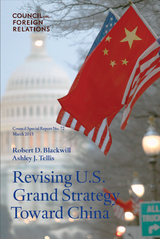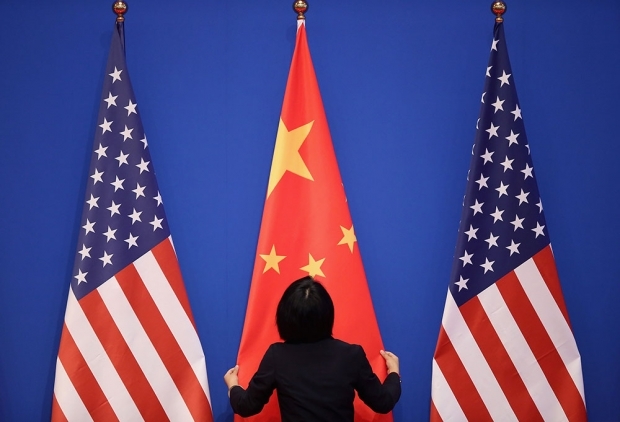Is it time for the United States to get serious about balancing China? According to Robert Blackwill and Ashley Tellis, the answer is an emphatic yes. In a new Council on Foreign Relations report, they portray China as steadily seeking to increase its national power, reduce the U.S. security role in Asia, and eventually dominate the international system. To deal with this clear challenge to U.S. primacy, they call for “a new grand strategy toward China that centers on balancing the rise of Chinese power rather than continuing to assist its ascendancy.”
In their view, success in this endeavor will require the United States to revitalize its economy, build preferential trading arrangements with Asian partners (such as the Trans-Pacific Partnership), deny critical technology to Beijing, and shore up U.S. and allied military capabilities in Asia. They also recommend that Washington strive to manage Sino-American relations through sustained high-level engagement with Beijing, and good things like that. But their overriding goal is to “limit China’s capacity to misuse its growing power.”
Reports
04.01.15
Revising U.S. Grand Strategy Toward China
Needless to say, it is hard for a realist like me to find much fault with these prescriptions (and other prominent realists have been sounding similar warnings for some time now). But recognizing the need to balance a rising power just gets us started: The critical question is how one goes about it—and where one draws the line. And though Blackwill and Tellis’ report does offer an imposing array of steps to be taken, it doesn’t answer that crucial question directly.
Here’s the core of the problem. In international politics, the capacity to shape existing norms, institutions, and political arrangements—aka the “status quo”—depends primarily on relative power. As the balance of power shifts, rising states invariably try to revise the status quo in ways that benefit their interests. This tendency makes perfect sense. Why would any country want to tolerate arrangements that were not to its advantage?
If China’s power continues to grow, therefore, it will inevitably seek further adjustments to the current international order. It would be naive indeed to expect Beijing to passively accept institutional and territorial arrangements created by others and especially those features of the existing order that were put in place while China was weak. It is all well and good to advise China to become a “responsible stakeholder,” as former World Bank President Robert Zoellick once did, but having a bigger stake in the system doesn’t preclude trying to revise certain parts of it as well. Beijing won’t seek to overturn features of the existing order that it likes, of course, only those it regards as inimical to its own security or long-term prosperity.
Media
04.14.15
Henry Paulson: ‘Dealing with China’
from Asia BlogBut how far should this process of adjustment proceed? Even if we recognize that a rising China will inevitably enjoy greater influence and might even have legitimate reasons to adjust the status quo in some areas (such as voting shares within the International Monetary Fund), that admission hardly implies allowing Beijing to have anything its leaders might want. The crucial question is easy to ask but hard to answer: Where should the United States (and others) draw the line?
What makes this issue especially tricky is the importance of preserving some degree of Sino-American amity. Taken together, China and the United States amount to a third of the world’s economy and about 25 percent of the world’s population. If Washington and Beijing maintain constructive relations over the next several decades, it will be easier to address critical global issues such as climate change, global health, macroeconomic management, and even some tricky regional conflicts. As former Australian Prime Minister Kevin Rudd put it in a recent Financial Times op-ed:
The future of the US-China relationship is not predetermined.… [The two states] have more common interests than may meet the eye. The world faces a growing list of challenges that are too big for even the strongest countries to solve alone. International institutions are often not up to the task, either. This is an opportunity to make common cause.
Rudd’s position is cogent, and his recommendation that the United States and China develop a “strategic framework” to manage areas of contention is appealing. But the greater the value the United States places on these broad elements of cooperation, the less inclined it will be to resist China’s efforts to revise other elements of the status quo, especially when the issues in dispute at any point in time seem relatively modest.
A perfect illustration is China’s current effort to “create facts” in the South China Sea. This campaign began with the invocation of the infamous “nine-dashed line,” a transparent attempt to lay claim to a maritime area that existing law of the sea would apportion among all of the littoral states. Vietnam, the Philippines, Malaysia, and others have protested China’s claims vigorously and favor a diplomatic solution, but in the meantime Beijing is building up disputed reefs, shoals, and islets and is increasing its physical presence.
Here’s the rub: Compared with the need to maintain global economic growth or prevent irreversible and potentially catastrophic damage to the Earth’s atmosphere, going to the brink over some piles of sand around Mischief Reef doesn’t seem all that significant. It’s a classic use of “salami tactics,” where a revisionist power seeks to alter the status quo through a series of small steps, each of them seemingly innocuous but whose cumulative impact could be enormous.
Does anyone in the United States want to blow up relations with Beijing over this issue or invite a direct clash of arms? I rather doubt it. But if that’s the case, then I repeat: Where do you draw the line? What risks should the United States be willing to run, and what costs should it be willing to pay to prevent the gradual Chinese assertion of de facto (and conceivably de jure) control over this region? To believe that one can balance Chinese power and run no risks at all is just as naive as believing one can avoid all trouble by persuading Beijing to embrace liberal institutions that were mostly made-in-America.
At this point it is useful to remind ourselves (and others) that the United States is not a “pitiful, helpless giant.” China’s economy may overtake America’s in absolute terms in the next few years, but U.S. per capita income is far higher and China still has to devote a greater share of national income to meeting basic needs. America’s military capabilities still dwarf China’s by a considerable margin, and its geopolitical environment is much more favorable. The United States has two friendly countries on its borders (Canada and Mexico), and no powerful enemies or nuclear-armed states nearby. By contrast, China has 14 countries on its borders, four of them with nuclear weapons, and relations with several of these neighboring countries are—to put it mildly—delicate.
Moreover, the United States has formal alliance treaties with Japan, South Korea, the Philippines, and Australia, and it engages in significant security cooperation with several of China’s other neighbors. Beijing, by contrast, has no treaty ties or security relations of any consequence with any countries in the Western Hemisphere. And the stronger and more assertive China becomes, the more that its neighbors are likely to welcome U.S. backing. America’s favorable geography gives it easy access to the world’s oceans, whereas Chinese shipping must pass through a series of straits and passageways that would be easy to blockade in time of war.
From Beijing’s perspective, in short, a deteriorating relationship with Washington is something to be avoided, especially when Chinese exports to the United States are about twice as large (as a percentage of GDP) as U.S. exports to China. Both countries have an interest in maintaining mutually beneficial economic ties, but China needs them even more than the United States does.
America’s many advantages do not mean that Washington can simply dictate to Beijing or prevent any and all changes to the existing status quo. But it does mean U.S. leaders do not need to be too skittish about drawing lines and setting limits, especially when they think critical U.S. interests are involved and when its regional allies agree.
But the question remains: Where should we draw the line? Blackwill and Tellis don’t say (though they do call for more proactive and vigorous responses, especially in the cyberspace realm). To be honest, I’m not entirely sure myself, but here are two principles to keep in mind.
First, as Blackwell and Tellis note (and as I’ve emphasized in the past), any effort to balance China more energetically will require a lot of buy-in from Asian states that have the most to fear from Chinese dominance. Managing these alliance relations will not be easy, however, for three reasons: 1) some of these states remain wary of each other; 2) none of them will want to disrupt their own economic ties with China; and 3) the distances involved are vast and tend to magnify the usual collective-action problems.
The United States also has to walk a fine line in managing these relations: doing enough to help protect key allies but not so much that they free-ride excessively or engage in overly provocative actions of their own (such as a Taiwanese bid for independence). Getting Asia right going forward will also require a cadre of smart, tough-minded, and well-trained officials who understand the region as well as their Chinese counterparts. Effective balancing behavior doesn’t just occur automatically; it needs to be facilitated by sustained, shrewd, and sympathetic diplomacy.
Second, though Blackwill and Tellis do not address it, making China the centerpiece of U.S. grand strategy will require Washington to set priorities more carefully than it has in the past two decades and avoid costly quagmires in other places. The era when the United States could dominate most of the world’s regions simultaneously is over; today U.S. leaders have to concentrate more on vital interests and steer clear of quixotic crusades. The neoconservatives’ disastrous Middle East adventures were the greatest gift Beijing could have wished for, and pushing Moscow into Beijing’s arms makes little sense if China is the real long-term peer competitor. Yet the current field of Republican presidential candidates seems to have learned nothing from these past errors and seems all too willing to repeat them. As a respected member of the Republican Party’s vanishing realist wing, Blackwill could do the nation a great service by bringing some much-needed sanity back to the party’s foreign-policy discussions.




